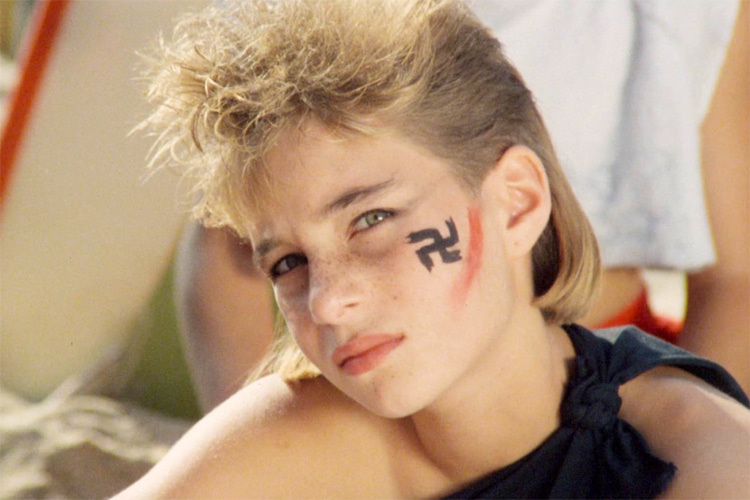Surfing, a sport deeply rooted in the harmonious embrace of nature, seemed an unlikely candidate for any association with National Socialism, the ideological machinery that powered Hitler's regime and slaughtered millions.
However, the truth is that the unexpected politics-meet-sports "alliance" turned real and once shook the sport's Aloha spirit.
Since surfing was exported from Hawaii in the early 20th century and throughout the decades, Nazi iconography has always been present in one form or another.
In 2022, Josh Greene released "Waves Appart," a 25-minute documentary about the influence of Nazi ideology in California surf culture from the early days to the modern age.
Greene, a Southern California-based filmmaker with Jewish roots, dissected the antisemitic origins of his favorite pastime.
The movie was one of the seven finalists of the Student Academy Awards nominated for the Oscars. It's worth watching.
But when and how did exactly the German's hideous far-right ideology infect surfers and surfing?
The Swastika Surfboard
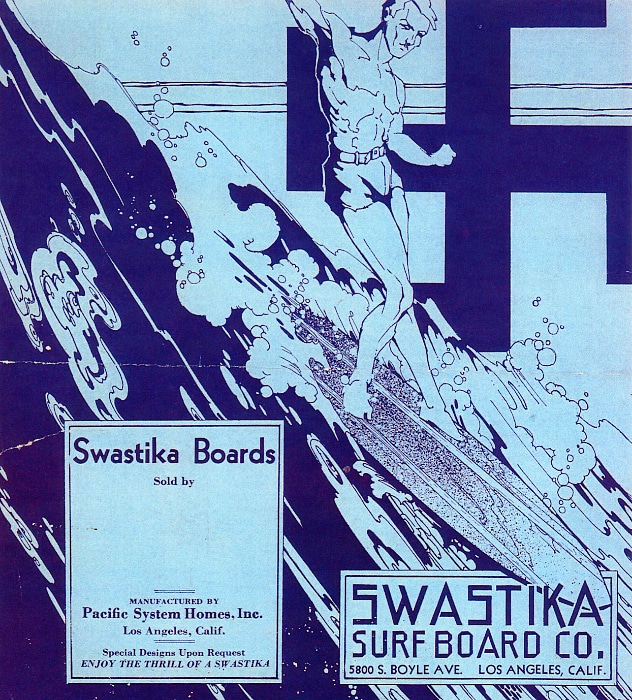
It all started in the 1930s, before the start of World War II.
A swastika emblem - previously adopted by Native Americans, Vikings, and Greeks as a token of prosperity and unity - was either etched or stamped onto the reverse of every Pacific System Homes' (PCH) "Swastika" model surfboard until 1937.
The apparently naive move would soon have consequences.
In the subsequent year, following the invasion of Austria by the German military adorned with swastikas, PCH was forced to rename its lines to "Waikiki Surfboards."
But the damage had been done, and the seeds of impactful Nazi propaganda had been planted.
The Nazi Stormtroopers
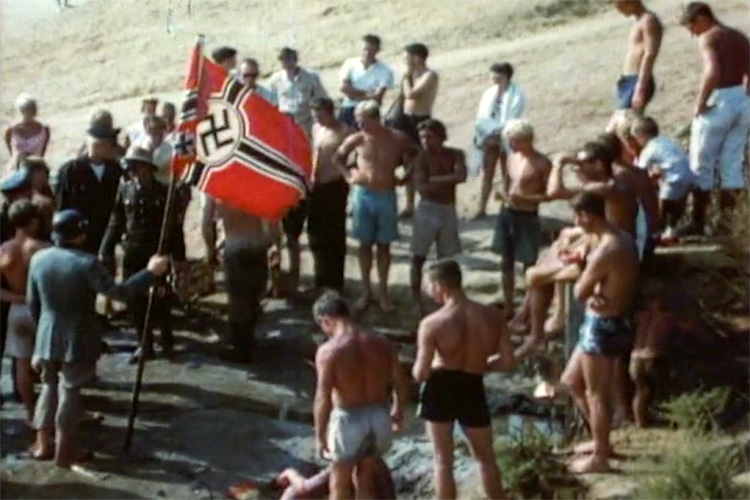
Between 1957 and 1961, Greg Noll and Bruce Brown, the director of "The Endless Summer," released a five-movie series called "Search for Surf."
In one of the films, you can see Californian surfers donning Nazi stormtrooper outfits as they maneuvered Flexi-Flyers in a storm drain, with companions displaying a Third Reich flag nearby.
"We just did things like that to be outrageous," Noll recalled years later.
"You paint a swastika on your car, and it would piss people off. So what do you do? You paint on two swastikas."
Sieg Heil: The 1961 Surf Nazi Salute
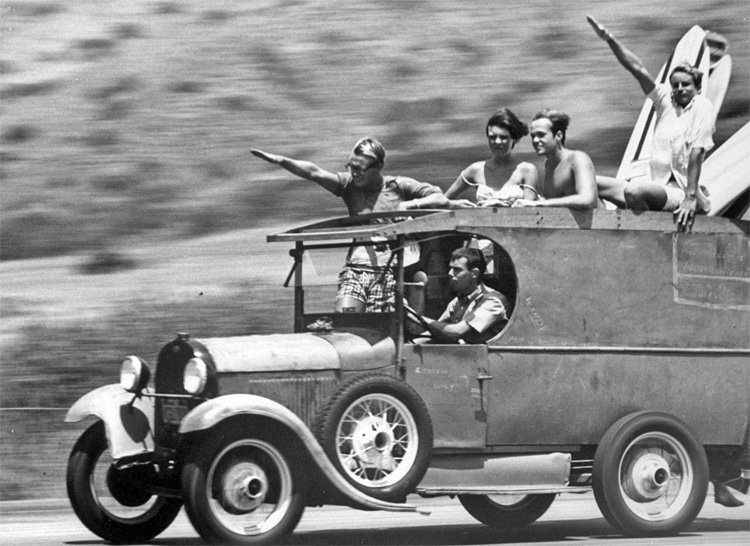
And then there's the famous picture in which a group of surfers perform Nazi's sieg heil salutes in a surf wagon.
One of those surfers was Bob Feigel, advertising director at Surf Guide magazine and manager of the original Makaha Skateboard team.
In 2019, he explained to the Encyclopedia of Surfing how the shot made it to Life magazine's September 1961 issue.
"My friend Paul Fritz had a classic old Ford milk truck that he sometimes used for surfing trips (the boards fit beautifully, but the truck could be a tad temperamental)," Feigel recalled.
"On this day, Paul picked me up on his way to Malibu."
"I can't remember who asked whom, but the Life people wanted shots of some surfers tooling down Pacific Coast Highway in the truck, and we ended up driving up to Arroyo Sequit to accommodate them."
"The shoot itself was not fun at all."
"We kept driving up and down PCH while the photographer [Allan Grant] shouted instructions, which we attempted to follow."
"It seemed to take hours. To relieve some of the boredom, I put my hand up in the air to feel it lift my hand as we drove by again."
"It wasn't a Nazi salute, but close enough."
"On the next run, the photographer asked us to do a Nazi salute as we drove by, and two of us foolishly obliged."
"Of course, that was the shot that appeared in Life. So a large part of the whole 'Surf Nazi' image was manufactured by the media."
The Surfer's Cross
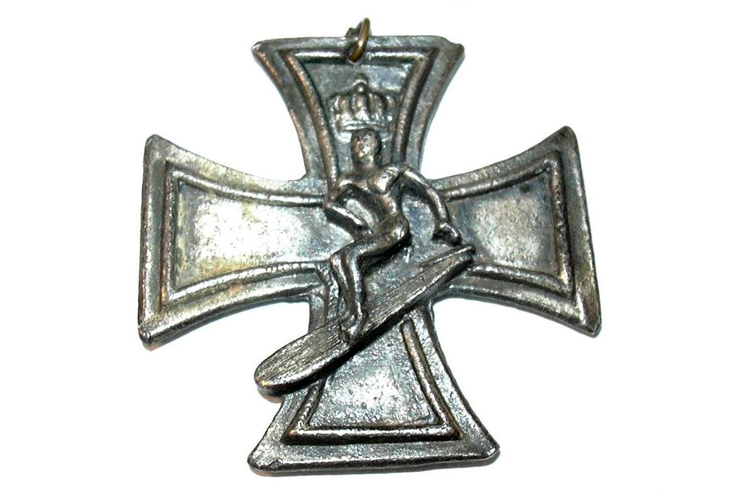
In the vibrant 1960s, artist and custom car visionary Ed "Big Daddy" Roth, famed for his Rat Fink cartoon, brilliantly tapped into American teenage dissent.
His 1965 release, the Surfer's Cross decals and necklaces, was inspired by the German Iron Cross, a military accolade once possessed by figures like Hitler and the Red Baron.
Within six months, the Surfer's Cross surged in popularity, with a factory in Rhode Island dispatching 24,000 pieces daily, reaching stores from the Midwest to the upscale Bergdorf Goodman in Manhattan.
This phenomenon didn't escape Time magazine's notice.
For the publication's feature, Roth donned a basic ensemble: jeans, a white tee, and his signature Surfer's Cross necklace resting atop his abdomen, all while straddling a moped with a cheeky grin.
And Roth wasn't stopping there.
He was set to launch a plastic version of the Wehrmacht iron helmet, drawing criticism from the surf media.
Yet, Roth remained defiant, cheekily crediting the German dictator to Time: "You know, that Hitler did a helluva public relations job for me."
Roth also explained his motivations in an in-depth interview with Surfer magazine.
"The surfers picked the cross for a good luck symbol," explained the controversial character.
"But the real reason it's become so popular with surfers is that, basically, the Iron Cross is a good design. Not because they're pro-Nazi."
"It's the same with the Chiquita Banana stickers, which were a huge fad. That's a good design, too. That's why kids dig 'em. Not because they're pro-banana."
"The cross itself has not hurt the sport! For anyone who's not hip to what's happening, I want to say that these surfers who wear the cross are not neo-Nazis."
The Open Racism of Miki Dora
Miki Dora, often dubbed the "King of Malibu," remains an iconic figure in California's surfing history.
However, beneath his athletic prowess, blasé attitude, and coastal cool lies a more sinister reputation.
Dora was known for displaying swastikas on his surfboards, a symbol associated with Nazi Germany.
His inclination towards such imagery hinted at a potential admiration or alignment with the ideologies that the swastika represents.
The release of the movie "Gidget" in 1959 led to an influx of newcomers to the Malibu surfing scene.
It's noted that when Dora and his Malibu crew discovered that Kathy Kohner, the real-life inspiration for the Gidget character, was Jewish and her father had fled Nazi Germany, they retaliated.
A member of the crew painted a swastika on the Kohner's driveway, signaling a direct antisemitic act.
David Rensin's book, "All for a Few Perfect Waves: The Audacious Life and Legend of Rebel Surfer Miki Dora," highlights instances where Dora frequently used racial slurs.
He also held prejudiced economic beliefs, warning acquaintances about Mexicans and blacks coming over the borders, implying they would ruin the economy.
While in prison, Dora expressed his affection for American Nazis in letters, suggesting a direct admiration for their beliefs and ideologies.
Dora chose to move to South Africa during the apartheid era.
His statements during this time, as recounted by surfboard designer Dale Velzy, reflect a colonialist and racist mindset.
He praised the subservient role of black people, referring to them derogatorily as "coolies," and made alarming remarks about black South Africans being "flesh-eaters."
World surfing champion Nat Young's interaction with Dora provides an eye-opening perspective.
Young described Dora as a staunch racist who genuinely believed in white supremacy.
This wasn't just a persona or facade; it was a deeply ingrained belief system.
Miki Dora's public remarks about race and religion were not only offensive but also consistent, showcasing his genuine antisemitic and racist views.
They weren't just one-off comments or jokes; they were repeated affirmations of his bigoted mindset.
In essence, whether viewed as a genuine white supremacist or someone who enjoyed pushing societal buttons, Miki Dora's behaviors and beliefs placed him firmly in the sphere of racism and antisemitism.
His actions and words reflected a deep-seated prejudice that marred his legacy in the surfing world.
"Surf Nazis Must Die"
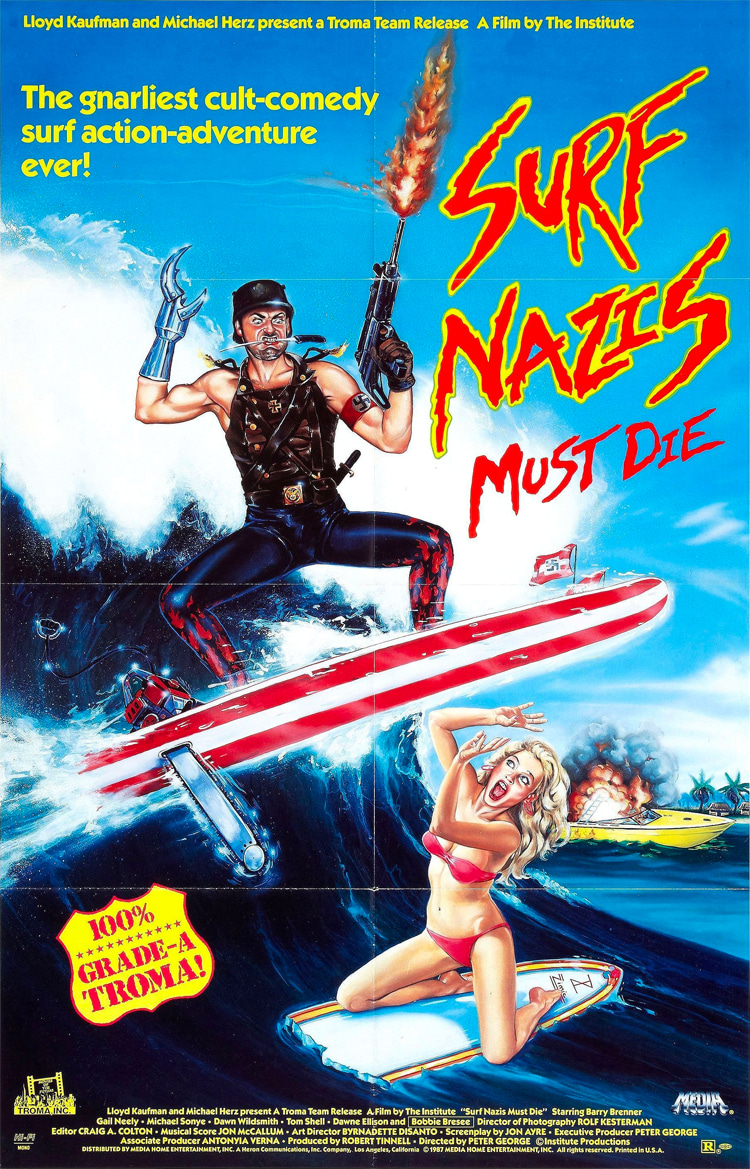
And when you thought things couldn't get more bizarre, "Surf Nazis Must Die" sees the light of day.
The 1987 American exploitation action film directed by Peter George is set in a post-apocalyptic future where the California coastline has been destroyed by a massive earthquake.
In this chaotic backdrop, neo-Nazi surf punks (the "Surf Nazis") rise to power and control the beaches, terrorizing anyone who stands in their way.
When the Surf Nazis kill a young African American man, his mother (Eleanor "Mama" Washington) seeks vengeance, leading to a violent showdown.
While the film was not particularly well-received by mainstream critics, its unique blend of surf culture and post-apocalyptic themes, combined with a title that's hard to forget, has made it endure in certain circles as a representation of 1980s B-movie culture.
Matt Hoy's Controversial Iron Cross Sprayjobs
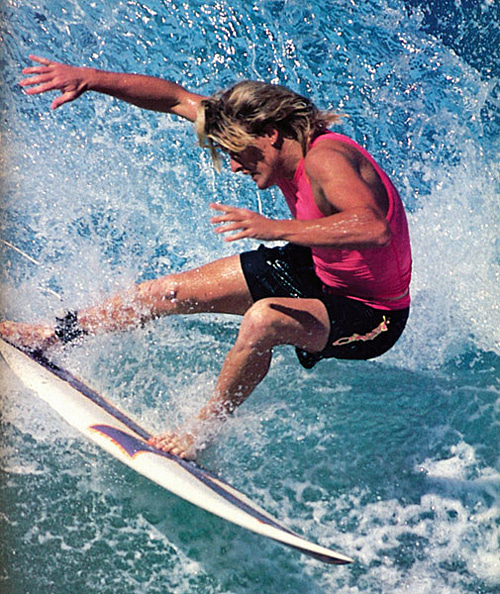
In the early 1990s, Australian professional surfer Matt Hoy started featuring a prominent Iron Cross on his surfboard's deck.
Although Surfing magazine acknowledged that Hoy recognized the Iron Cross as a "symbol of Nazi power," he viewed it merely as a representation of "strength and winning."
In 1992, a reader of Surfing magazine expressed concern over Hoy's use of the Iron Cross, which had associations with Hitler.
In response, the magazine clarified that Hoy was "neither a member of nor believer in the Nazi party."
